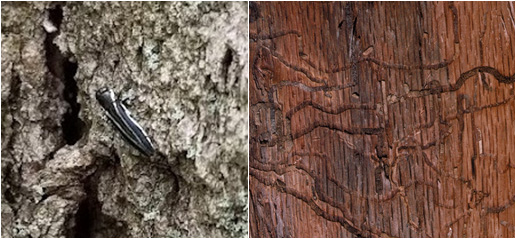Issue 5, June 22, 2022
Twolined Chestnut Borer
Twolined chestnut borer (Agrilus bilineatus) is a small, native, jewel beetle (Family: Buprestidae) that bores into American chestnut, black oak, bur oak, chestnut oak, live oak, pin oak, post oak, red oak, scarlet oak, white oak and, occasionally, beech trees.
Twolined chestnut borer is usually a secondary pest, attacking trees that are already stressed. Tree stressors can include disease, drought, mechanical injury from construction or storm damage, and damage caused by other insects. In areas where spongy moth (Lymantria dispar; historically named gypsy moth) is present, twolined chestnut borer may attack trees following spongy moth defoliation. Nursery plants are also at risk for borers because of the stress of transportation and transplant.
The larvae feed in the cambium of the tree, creating random trails that can be seen when dead bark is peeled back. Larval feeding can disrupt nutrient flow within the tree leading to injury.

Left: Twolined chestnut borer adult 6/10/22, Sarah Hughson, University of Illinois at Urbana-Champaign. Right: Twolined chestnut borer damage under bark, James Solomon, USDA Forest Service, Bugwood.org
Early signs of twolined chestnut borer injury are wilted foliage in late summer. Leaves may turn brown and stay on the tree, but the branches will die. Dieback of twigs and branches occurs from the top of the tree downward. The borers may take upto 5 years to kill a tree.
As adult beetles emerge from the trees, they create D-shaped exit holes about 1/8 of an inch wide. The beetles are greenish-black with two white to gold stripes running down their back. There is some variation in the stripes among individuals. The stripes may be very obvious in some individuals (as pictured above) or pale and vanishing in others.
The beetles are usually active and can be scouted for from April in southern Illinois to June in northern Illinois. When scouting, look for adults flying around and landing on tree trunks, particularly on the sunny side of the trunk.
Because twolined chestnut borer attacks stressed trees, the best prevention is maintaining good tree health. Avoid stressors such as soil compaction and water during dry periods to prevent drought stress. However, if twolined chestnut borers are damaging the tree, they can be treated. When adults are active, they can be controlled by spraying the lower 4 ½ ft of the trunk with imidacloprid (Enforce). Larvae can be treated by soil-drench with imidacloprid. It is important to remember that systemic treatments like imidacloprid should be applied after the trees have finished flowering and pollinating to avoid harming pollinators.
Author:
Sarah Hughson